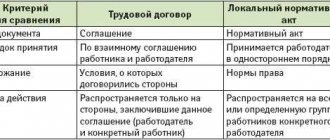Who is a programmer?
What does the job description say about the profession? A programmer is a specialist in the field of IT technologies who has professional computer skills and is able to create and use various types of computer programs. A representative of the profession in question must be energetic, sociable and only positive.
How can such a job be obtained? The programmer, the instructions prescribe, must have a higher technical education. Only in this case can he be appointed to the position by order of the General Director of the IT department.
The programmer must have excellent knowledge of:
- on labor legislation;
- about various kinds of regulations, acts and norms relating to the professional activities of a programmer;
- on labor rules and regulations;
- about safety precautions.
Rights and responsibilities of a programmer
Like any other worker, the programmer has certain rights and functions.
What rights does the job description prescribe?
- The programmer has the right to identify and eliminate various causes and factors that interfere with effective work activity.
- The programmer has the right to send various kinds of wishes, requests and proposals to the management of the enterprise regarding improving the efficiency of work.
The rights of a representative of the profession in question, although they fit in only two points, are nevertheless quite fair and disclosed. What responsibilities does an IT specialist have, and what does the job description say about them? The programmer, according to the standards, is endowed with the following functions:
- program development and testing;
- development of a methodology for solving the problem;
- identification of required information;
- determining the content and scope of data;
- starting and stopping programs;
- ensuring proper operation of programs;
- preparing equipment for operation, repairing some equipment.
Only the most basic functions of the specialist in question were mentioned above. Of course, there could be much more.
II. Job responsibilities
Software engineer:
2.1. Based on the analysis of mathematical models and algorithms for solving economic and other problems, he develops programs that make it possible to execute the algorithm and, accordingly, the assigned task using computer technology, and carries out their testing and debugging.
2.2. Develops technology for solving problems at all stages of information processing.
2.3. Selects a programming language to describe algorithms and data structures.
2.4. Determines information to be processed by computer technology, its volume, structure, layouts and schemes for input, processing, storage and output, methods of its control.
2.5. Performs work on preparing programs for debugging and carries out debugging.
2.6. Determines the scope and content of test case data that provides the most complete verification of programs' compliance with their functional purpose.
2.7. Launches debugged programs and enters initial data determined by the conditions of the assigned tasks.
2.8. Conducts adjustments to the developed program based on analysis of the output data.
2.9. Develops instructions for working with programs, draws up the necessary technical documentation.
2.10. Determines the possibility of using ready-made software products.
2.11. Provides support for the implementation of programs and software.
2.12. Develops and implements systems for automatically checking the correctness of programs, standard and standard software, and develops information processing technology.
2.13. Performs work on unification and typification of computing processes.
2.14. Takes part in the creation of catalogs and file cabinets of standard programs, in the development of forms of documents subject to machine processing, in the design of programs that allow expanding the scope of application of computer technology.
2.15. [Enter as appropriate].
What is a software engineer?
The job description of a software engineer states that the specialist in question is appointed by order of the general director.
He reports to either the head of the department or the technical director. To obtain a position as a software engineer, you must have a higher technical education and at least one year of work experience.
The specialist in question must have excellent knowledge of a wide variety of types of software, the principles of structured programming, and technologies and methods for processing and encoding information. It is advisable that the specialist also have an understanding of formalized programming languages, as well as the order and methods of document preparation.
A software engineer can only be guided by the charter of the enterprise, its regulations and legislative acts of the Russian Federation.
Rights, duties and responsibilities of a software engineer
The job description of a software engineer prescribes the following rights for the employee:
- the right to be aware of innovations relating to the professional activities of a specialist;
- the right to submit various projects and wishes to management for consideration;
- the right to demand assistance from management (depending on the situation);
- the right to report existing problems to management.
What can you find about the responsibilities of the specialist in question? Here's what the job description says:
- a programmer-engineer is required to develop programs and test them based on mathematical analysis;
- is obliged to develop methods for solving problems;
- must select the program language;
- must define the information to be processed;
- is obliged to check the software products before use.
Depending on where a software engineer works, their job functions may vary slightly.
It is also worth noting that the software engineer is responsible for the incorrect performance of his work activities, for negligence, for violation of discipline and safety regulations.
Programmer job description
564 74917
We bring to your attention a typical example of a programmer job description, sample 2020. Don’t forget, every programmer’s instruction is handed out against a receipt.
The hr-portal website provides typical information about the knowledge that a programmer should have. About duties, rights and responsibilities.
This material is included in the huge library of job descriptions on our website, which is updated daily.
General provisions
1. The programmer belongs to the category of specialists.
2. Programmer of category I: higher professional (technical or engineering-economic) education and work experience as a programmer of category II for at least 3 years.
(-programmer of category II: higher professional (technical or engineering-economic) education and work experience as a programmer of category III or other engineering positions filled by specialists with higher professional education, at least 3 years.
- programmer of category III: higher professional (technical or engineering-economic) education and work experience in the specialty acquired during the training period, or work experience in engineering positions without a qualification category.
- programmer: higher professional (technical or engineering-economic) education without requirements for work experience or secondary vocational (technical or engineering-economic) education and work experience as a category I technician for at least 3 years or other positions filled by specialists with secondary education professional education, at least 5 years.)
3. The programmer is hired and dismissed by the director of the organization.
4. The programmer must know:
— guidelines and regulatory materials regulating methods for developing algorithms and programs and using computer technology in information processing, the basic principles of structured programming;
— types of software;
— technical and operational characteristics, design features, purpose and operating modes of the computer, rules for its technical operation;
— automatic information processing technology;
— types of technical storage media;
— methods of classification and coding of information;
— formalized programming languages;
— current standards, number systems, ciphers and codes;
— procedure for preparing technical documentation;
— advanced domestic and foreign experience in programming and using computer technology;
— fundamentals of economics, organization of production, labor and management;
— basics of labor legislation;
— internal labor regulations;
— rules and regulations of labor protection, safety precautions, industrial sanitation and fire protection.
5. In his activities, the programmer is guided by:
- legislation of the Russian Federation,
- Charter of the organization,
- orders and instructions of employees to whom he is subordinate in accordance with these instructions,
- this job description,
— Internal labor regulations of the organization.
6. The programmer reports directly to __________ (indicate the position of the employee to whom he reports).
7. During the programmer’s absence (business trip, vacation, illness, etc.), his duties are performed by a person appointed by the director of the organization in the prescribed manner, who acquires the corresponding rights, duties and is responsible for the performance of the duties assigned to him.
Job responsibilities of a programmer
Programmer:
1. Based on the analysis of mathematical models and algorithms for solving economic and other problems, develops programs that provide the ability to execute the algorithm and, accordingly, the assigned task using computer technology, tests and debugs them.
2. Develops a technology for solving a problem at all stages of information processing.
3. Selects a programming language to describe algorithms and data structures.
4. Determines information to be processed by computer technology, its volume, structure, layouts and schemes for input, processing, storage and output, methods of its control.
5. Performs work on preparing programs for debugging and carries out debugging.
6. Determines the volume and content of these test cases, providing the most complete verification of the compliance of programs with their functional purpose.
7. Launches debugged programs and enters initial data determined by the conditions of the assigned tasks.
8. Conducts adjustments to the developed program based on analysis of the output data. Develops instructions for working with programs, draws up the necessary technical documentation.
9. Determines the possibility of using ready-made software products.
10. Provides support for implemented programs and software.
11. Develops and implements systems for automatically checking the correctness of programs, standard and standard software, and develops information processing technology.
12. Performs work on unification and typification of computing processes.
13. Participates in the creation of catalogs and file cabinets of standard programs, in the development of forms of documents subject to machine processing, in the design of programs that allow expanding the scope of application of computer technology.
14. Complies with the internal labor regulations and other local regulations of the organization.
15. Complies with internal rules and regulations for sales, safety, industrial sanitation and fire protection.
16. Ensures cleanliness and order in his workplace,
17. Carry out, within the framework of the employment contract, the orders of the employees to whom he is subordinate in accordance with these instructions.
Programmer rights
The programmer has the right:
1. Submit proposals for consideration by the director of the organization:
— to improve work related to the responsibilities provided for in this instruction,
- on encouraging distinguished employees subordinate to him,
- on bringing to material and disciplinary liability the employees subordinate to him who have violated production and labor discipline.
2. Request from structural divisions and employees of the organization the information necessary for him to perform his job duties.
3. Get acquainted with the documents defining his rights and responsibilities for his position, criteria for assessing the quality of performance of official duties.
4. Get acquainted with the draft decisions of the organization’s management relating to its activities.
5. Require the management of the organization to provide assistance, including ensuring organizational and technical conditions and execution of the established documents necessary for the performance of official duties.
6. Other rights established by current labor legislation.
Programmer Responsibility
The programmer is responsible in the following cases:
1. For improper performance or failure to fulfill one’s job duties provided for in this job description - within the limits established by the labor legislation of the Russian Federation.
2. For offenses committed in the course of their activities - within the limits established by the current administrative, criminal and civil legislation of the Russian Federation.
3. For causing material damage to the organization - within the limits established by the current labor and civil legislation of the Russian Federation.
Job description for a programmer - sample 2020. Job responsibilities of a programmer, rights of a programmer, responsibility of a programmer.
About the lead programmer and his responsibilities
The lead programmer is appointed by the general director and reports to the technical director. Naturally, the leading programmer must have a higher technical education.
The leading programmer is distinguished by his computer skills at a professional level and the ability to develop complex special programs. Nothing else characterizes the lead programmer as well as listing his job responsibilities. So, here are the functions that fall within the competence of the lead programmer:
- assigning tasks to programmers and monitoring their implementation;
- development of tasks for the department;
- checking programs for compliance with standards;
- providing assistance to programmers in the department;
- carrying out inventory;
- control of enterprise property;
- informing superiors about existing problems.
Thus, the name of the profession speaks for itself. In fact, the lead programmer is a kind of “headman” in the department.
About the responsibilities and rights of the lead programmer
The job description of the lead programmer prescribes the following rights for the lead programmer:
- the right to demand from superiors all necessary official information;
- the right to demand from management the equipment necessary for work;
- the right to identify and eliminate reasons that in one way or another impede the effective operation of the enterprise;
- the right to send wishes and demands to improve work to superiors;
- the right to submit petitions to superiors for bonuses or penalties for employees.
Thus, the lead programmer has much more rights than the ordinary one. But the more rights, the greater the responsibility. Thus, the specialist in question is responsible for:
- failure to perform or poor quality performance of their functions;
- failure to perform or poor quality performance of functions by the department;
- providing false information about the work of the department;
- disclosure of trade secrets;
- failure to follow orders from superiors.
The specialist in question has a very responsible job. A leading programmer is a focused person who is attentive to his work.
I. General provisions
1. A person with secondary vocational education and additional professional education under a continuing education program is appointed to the position of programmer.
2. At least 6 months of practical experience in the field of software development.
3. Appointment to the position of programmer, as well as dismissal from it, is made by order of the head of the organization.
4. The programmer must know:
4.1. Methods for automatic and automated testing of software functionality
4.2. Main types of diagnostic data and methods of their presentation
4.3. Languages, utilities and programming environments, and tools for batch execution of procedures
4.4. Typical Software Metrics
4.5. Basic methods for measuring and evaluating software characteristics
4.6. Methods for creating and documenting test cases and test datasets
4.7. Rules, algorithms and technologies for creating test data sets
4.8. Requirements for the structure and storage formats of test data sets
4.9. Methods and tools for checking software functionality
4.10. Software performance testing and debugging environment
4.11. Internal regulatory documents regulating the procedure for documenting the results of testing the functionality of software
4.12. Methods and tools for refactoring and optimizing program code
4.13. Internal regulatory documents regulating requirements for program code, the procedure for reflecting changes in the version control system
4.14. Internal regulatory documents regulating the procedure for reflecting the results of refactoring and optimization in the collective knowledge base
4.15. Methods and techniques for debugging program code
4.16. Typical errors that occur during software development, and methods for diagnosing and correcting them
4.17. _____________________________________________________________________
5. The programmer reports directly to ___________________.
6. During the programmer’s absence (vacation, illness, etc.), his duties are performed by a person appointed in the prescribed manner. This person acquires the corresponding rights and is responsible for their proper execution.
7. ________________________________________________________________
Programmer in a budgetary institution and his responsibilities
It’s worth saying right away that the work of the specialist in question in a budgetary institution is not much different from work in a commercial institution.
Thus, the job description of a programmer of a budgetary institution states that the employee is also appointed by the director of the institution and reports to him. Primary duties and responsibilities include forecasting, analysis and planning. As an example, consider a school programmer.
Job descriptions for a programmer at a school may be different, as they are edited directly at the educational institution itself. Nevertheless, some general provisions can be highlighted.
The school programmer must:
- analyze the state of the school computer park;
- monitor the state of the computer park;
- predict trends in the development of school technology;
- organize the use of technology;
- maintain documentation on the state of the computer park.
It is worth noting that the school programmer is entrusted with enormous responsibilities. Moreover, if there is only one for the entire institution.
On the responsibilities and rights of a programmer in a budgetary institution
Despite the fact that the job description of a programmer in an institution may vary, one thing is for sure: the responsibility of a programmer at school or in other places is always enormous.
It is worth noting the vagueness of the wording in the job description:
- responsibility for involvement in violation of the [educational] process;
- liability for causing damage to the institution;
- for failure to fulfill duties, poor performance of duties, etc.
What rights are assigned to the programmer? The most basic ones can be highlighted:
- the right to advanced training;
- the right to make proposals for improving work;
- the right to request necessary documents from superiors;
- the right to negotiate with employees of the institution (school), etc.
III. Rights
A software engineer has the right:
3.1. Get acquainted with the draft decisions of the enterprise management concerning its activities.
3.2. Submit proposals for improvement of work related to the responsibilities provided for in these instructions for consideration by management.
3.3. Within the limits of your competence, inform your immediate supervisor about all shortcomings in the activities of the enterprise (structural divisions) identified during the performance of official duties and make proposals for their elimination.
3.4. Request personally or on behalf of your immediate supervisor from department specialists information and documents necessary to perform your job duties.
3.5. Involve specialists from all (individual) structural divisions in solving the duties assigned to him (if this is provided for by the regulations on structural divisions, if not, with the permission of the head of the enterprise).
3.6. Demand from your immediate supervisor and the management of the enterprise to provide assistance in the performance of their official duties and rights.
3.7. [Enter as appropriate].








